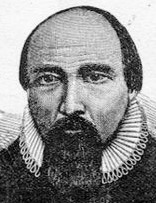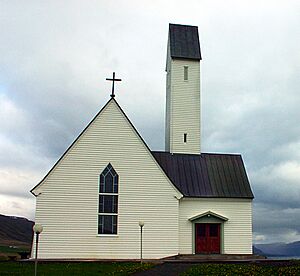Hallgrímur Pétursson facts for kids
Quick facts for kids
Hallgrímur Pétursson
|
|
|---|---|

Hallgrímur Pétursson
|
|
| Born | 1614 Gröf, Iceland
|
| Died | 27 October 1674 Ferstikla, Iceland
|
Hallgrímur Pétursson (born 1614, died 1674) was a famous Icelandic poet. He was also a minister, which is like a pastor or priest, in churches like Hvalsneskirkja and Saurbær. He is one of Iceland's most important poets. Two famous churches, Hallgrímskirkja in Reykjavík and another in Saurbær, are named after him. He was a very important religious leader during a time called the Age of Orthodoxy. This was a period (1580–1713) when the Lutheran church was very strong. Because he wrote so many great church songs, or hymns, people sometimes call him the "Icelandic Paul Gerhardt." Paul Gerhardt was a famous German hymn writer.
Contents
Hallgrímur's Life Story
Hallgrímur Pétursson was probably born in a place called Gröf in Skagafjörður, Iceland. He spent his childhood in Hólar. His father worked there as a bell-ringer. His cousin, Guðbrandur Þorláksson, was the bishop, a high-ranking church leader, in Hólar.
When Hallgrímur was a young man, he left Hólar. We don't know exactly why he left. He traveled to Europe, perhaps to learn how to be a blacksmith. He ended up in a city called Copenhagen. There, a kind man named Brynjólfur Sveinsson helped him. Brynjólfur paid for Hallgrímur to study at a special school for church leaders. Brynjólfur and Hallgrímur were related through marriage.
A Chance Meeting
There's a popular story about how Brynjólfur first met Hallgrímur. Brynjólfur was traveling through a town called Glückstadt. At that time, this town was part of Denmark. Hallgrímur was working for a blacksmith who treated him badly. Brynjólfur heard Hallgrímur complaining about his boss in Icelandic. Brynjólfur felt sorry for the young Icelander. He decided to help Hallgrímur get a good education.
New Beginnings
During his last year of studies, Hallgrímur had an important job. He was asked to help a group of Icelanders. These people had been kidnapped by pirates in 1627. This event is known as the Turkish Abductions. They were finally set free ten years later. Hallgrímur helped them learn about their culture and religion again.
Among this group was a woman named Guðríður Símonardóttir. She was sixteen years older than Hallgrímur. They fell in love. Guðríður was married to a man from the Westman Islands who had not been captured. When Guðríður became pregnant, Hallgrímur left his studies. He returned to Iceland with the group. When they arrived, they learned that Guðríður's husband had passed away. Hallgrímur and Guðríður then got married. Hallgrímur worked as a laborer for several years.
Becoming a Minister
Seven years after Hallgrímur came back to Iceland, Brynjólfur Sveinsson helped him again. Brynjólfur was now a bishop in Skálholt. He made Hallgrímur a minister at Hvalsnes. Some people were surprised because Hallgrímur hadn't finished his studies. But Hallgrímur proved to be a very good preacher.
In 1651, he was moved to a new church in Saurbær in Hvalfjörður. This was a very important position. He served there until he died in 1674. He passed away from leprosy, a serious illness.
Hallgrímur's Important Works
Hallgrímur Pétursson's most famous work is called Passion Hymns (Passíusálmar). This is a collection of fifty hymns, or church songs. People would sing one hymn each weekday during the seven weeks of Lent. Lent is a special time before Easter. Each hymn has a title that tells which part of the story of Jesus' suffering and death it is about. It also suggests a tune to sing it to.
He also wrote other well-known works. These include Aldarháttur, Rímur af Lykla-Pétri og Magellónu, and Króka-Refs rímur. He also wrote a collection of rhymes for children that taught important lessons.


